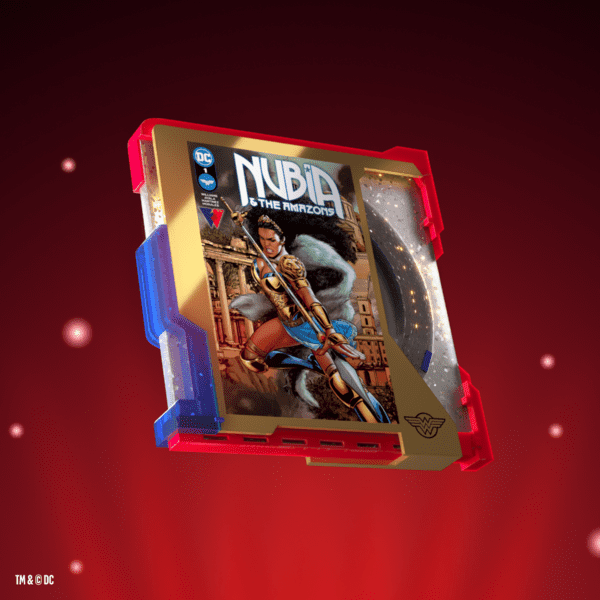Brands Explore Free NFTs – DC Comics, Burger King, and Dave & Busters

When we were writing The NFT Handbook back in April of this year, we wrote in great detail about the concept of Free NFTs – specifically how it was going to be the main NFT strategy used by legacy brands. And just 6 months later there are half a dozen use cases of this exact idea.
Free NFTs
In just 5 days (October 5th), DC Comics will open the floodgates to anyone that wants to get one of their free NFTs. That’s right, any single person that goes to this page on their website will be able to claim a comic-book-inspired NFT and cross their fingers they get a Legendary edition (not a Rare or Common). Decrypt predicts it’ll number in the millions of free NFTs.
What’s the catch?
Aside from the fact these will probably not be worth anything, it’s really just marketing for the DC Fandome event just a couple of weeks later. By signing up for the NFT, you’re also getting an invite to the online event. AND, if you share your NFT on social media you can get a second Free NFT.
In other words, it’s a marketing campaign.
Reminds me of the Space Jam free NFTs from back in July, which was marketing for the movie.
Also, reminds me of the Burger King NFTs they’re currenly giving away to people who purchase one of their new Keep It Real Meals – their health conscious offering.
And how about Dave & Buster’s new NFT program where every location offers a different collectible NFT coin and the first person to collect them all gets $10k at D&Bs.
Yeah, these Free NFT programs are really catching steam. Whether or not these NFTs are actually driving sales to Burger King and D&Bs or giving a social lift to Space Jam and DC Fandome is still to be determined.
What’s the Cost of a Free NFT?
Logistically, how do you possibly mint tens of thousands or even a million NFTs? I’ve claimed a few free NFTs on OpenSea, but I’m always responsible for the gas fee. The aforementioned brand NFTs aren’t charging gas.
The trick, then, is that many of them aren’t actually using the Ethereum blockchain. They’re using lesser-known blockchains or Ethereum sidechains where the activity is minimal, and thus the gas fee is negligible (perhaps non-existent).
For instance, the DC Comics free NFT drop is being issued on the Palm blockchain, which is an Ethereum sidechain.
The purpose of a sidechain is to provide scalability – like paving another lane on the highway. Except that in this case, the lanes aren’t actually merged. There is however, somewhat of a promise that in the future they’ll do what’s called a “rollup”, where they (Palm) rollup all their transactions and submit it to the Ethereum main chain. (In other words, merging the lanes.)
Ultimately, sidechains are less decentralized in nature and therefore more vulnerable to bad actors. They aren’t well-integrated into the greater NFT ecosystem, instead they are kind of doing their own thing in a silo. And there’s also no guarantee sidechains will ever merge with the main blockchain whether through a rollup or Layer 2 integration.
When you look at it through this perspective, the Free NFTs we see today aren’t all that interesting. It’s a flashy way of engaging with people through what’s popular today. But the way many brands are going about it really provides no longevity.
Not to mention, there’s also a brand cost. Yes, there’s a cool element to dropping NFTs today, but how will they age? And how will it affect future NFTs that they may want to sell? Free NFTs today could be a liability to future NFT plans.
Will People Stay Interested?
The main question here is what the longevity of Free Brand NFTs is. What’s the endgame with Space Jam’s, Burger King’s, and DC Comics’s free NFTs?
If it’s simply a “fireworks” marketing campaign – which means it’s meant to put on a spectacle for just a little bit – then I think we’re going to continue seeing more and more of these drops. Clearly, it works. And platforms like Palm minimize the costs.
But effectively they’re creating the equivalent of the free hat or free towel they give out at sporting events for attendees. It’s a nice souvenir, but not much more.
However, if these brands are serious about making collectibles that will either have value or general interest for years to come, then I think we still haven’t seen the right strategy at play.
Interestingly, Space Jam is about to launch a program where users can burn 3 of their Space Jam NFTs for a new NFT they’re releasing. This is a compelling idea because it’s slowly introducing more and more scarcity to their free collectible.
Naturally, owners would prefer burning the “common” editions over the rare or legendary ones. This in turn could actually flip the dynamics and turn some of the common editions into rarer pieces.
Overall, I don’t have a great take on the longevity of Free Brand NFTs. I’m at a loss for their long-term value proposition, outside of a cool moment in time that fans can say they were a part of.
Ready to Learn About NFTs?
Join 11,000+ readers of NFT QT, a weekly newsletter packed with tips and actionable insights for people fascinated with NFTs just like you.
